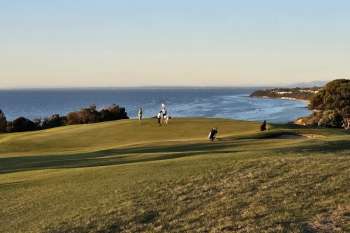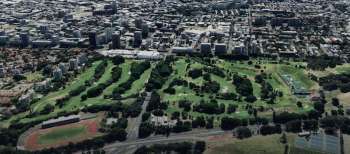Hidden Gems - Australia's Top 10 under-rated courses
With the next Australian Golf Digest Top 100 ranking still a year away, we decided it was time to look at some of this country’s best hidden gems. These are the courses that did not crack the magical 100 last time, but according to our panel sit right on the fringe. With the exception of an unheralded layout on Sydney’s northern beaches, the rest are regional courses that are typically welcoming of visitors and, better yet, inexpensive and fun to play.
In compiling this list, our panel was asked their views on Australia’s most under-rated courses, and those outside the Top 100 with the strongest claims for inclusion. There were arguments made for metropolitan clubs like Cranbourne, Keysborough, Southern and Pymble, which have jumped on and off the list at various times over the years, but pleasingly the judges favoured some of our lesser known country jewels. These are precisely the sort of courses that we hope our recently revamped judging panel will be able to rate and review on a more regular basis.
None of these layouts would be out of place on the Top 100, and we expect some to feature when the list is updated next year. Regardless of whether they are ranked or not, we know that readers will enjoy playing them.
Albany Golf Club, Western Australia
Were it not for its spongy Kikuyu fairways, Albany would most accurately be described as the Barwon Heads of the West. Home to the oldest golf course in the state, the club is set upon a charming seaside property that overlooks the King George Sound in southern Western Australia. The terrain here is ideal for links golf, with lovely ground undulations and fairways that stretch up and down along the coastline. The course is not overly long but the small targets, natural bumps and softly tumbling dunes as well as the ever-present offshore winds make scoring a challenge. Albany missed out on the Top 100 in 2012 by the barest of margins. With some subtle tweaks and a more authentic links turf this place would be fantastic. (DO)
Bribie Island Golf Club, Queensland
Bribie Island Golf Club possesses that rare mix of undulating-sandy terrain in a natural bushland setting. It is a picturesque golf course with fairways that heave and turn around vegetated doglegs and some beautifully conceived green complexes that sit naturally in their surrounds. Many of the bunkers are artistically shaped providing a throwback to the bunker style found on the Melbourne Sandbelt. What sets this course apart from many modern layouts is that it does not rely on length as its main defence. It is a thinking man’s course where a driver is not always the play from the tee and positional play into the fairways and greens is paramount. What is even more appealing is that it is always a joy to play – and there is no better accolade than that.
Bribie Island would easily sit in the top 100 if the club embarked on a selective tree removal program to open up vistas and playing lines. It would also benefit from adding a few more fairway bunkers to improve the strategy from the tee and utilise a consistent bunker style throughout the layout. The recent improvements to the bunkers as well as the wetland areas on the par three 16th and par four 18th are of the highest quality and if this style was applied throughout the layout, it would greatly enhance the aesthetics and strategy of the course. (Stephen Glen)
Fleurieu Golf Course, South Australia
Fleurieu is not well known, not designed by a famous architect and not the recipient of a benefactor’s largesse, in fact it is unbelievably maintained by only 3 greenstaff. Despite these ‘handicaps’ and the fact it appears to be patronized more by kangaroos than golfers, this course is eye-poppingly good. The layout is well considered and flows with the terrain beautifully, providing that ‘natural’ feel to the holes. There is an excellent mix of green sizes and complexity allowing for a variety of pin positions, which, depending on the wind, would provide for a lot of options when setting up the course.
Considering the nominal greens crew, the conditioning is baffling. Most courses have two or three times the staff numbers with less results. With a couple more staff tending to the finer points of conditioning I would consider this course a contender for a place inside Australia’s top 70.
Pick of the holes are; the short par four 6th, a classic risk/reward hole with a solid carry over wasteland and the 10th, a dogleg par five reachable in two but can be played a myriad of different ways. Another worthy contender is the par three 12th, a solid mid-to-long iron to a large green well protected by bunkers and a water hazard front right. (Aaron Spalding)
Tuncurry (Great Lakes) Course, Forster-Tuncurry Golf Club, New South Wales
With its unsealed driveway and clubhouse that looks more like a demountable classroom, the Tuncurry Course at Forster-Tuncurry Golf Club is perhaps more ‘hidden away’ than a true hidden gem. Once a member of our Top 100 rankings, the fairways that fold over the sandy base and are lined by ti-tree draw comparisons with the likes of Newcastle Golf Club to the south, without the finishing touches or more dramatic changes in elevation. Holes such as the uninspiring 200m par three 9th created a less than favourable impression the first time I played here, but I have fallen more in love with each passing round. The ti-tree on either side of the fairways, that once felt claustrophobic on the tee box, has been thinned out in more recent years but it only allows you to find your ball, not hit miraculous recovery shots to the green. A gentle freshen up and an injection of funds would put Tuncurry well and truly back on the Australian golf map. (Tony Webeck)
Lakes Entrance Golf Club, Victoria
Lakes Entrance golf club is a truly worthy stop for golf enthusiasts. The 18 holes wind their way through a series of lakes that from the start challenge your driving with two water carries to get you under way. But it is making the turn at 3 and 4 where you truly get the feeling you’re somewhere special, as you play the next five holes alongside the 90-mile beach and hear the crashing waves while making your way through a series of wonderful holes.
The back nine plays away from the beach and has more of a parkland feel, concluding with the 18th which sets up for a great tee shot over water back to the clubhouse, where you can reminisce on playing one of country Victoria’s true hidden gems. (Brian Man)
Long Reef Golf Club, New South Wales
Long Reef is one of those courses where you know you're going to have a great day irrespective of how you play. Its prime positioning on the Northern Beaches of Sydney ensures breathtaking views, plus the green fee doesn’t cost an arm and a leg. I remember playing Long Reef just weeks after returning from the United States, and a round at Pebble Beach. I recall thinking that if Pebble costs $500 per round then the Reef must be worth way more than they charge.
While it’s not the most brilliant of layouts there are a number of good holes, especially the finishing stretch, which runs along the Long Reef headland and beach. When the wind is blowing anything remotely close to your handicap is a great round.
In my opinion, the back 9 is much better than the front. Holes 1, 4, 7 are the pick going out but the run home is where the course comes alive. Holes playing into the wind or with a strong cross breeze become very difficult and this is most evident at the 10th, 12th, 16th and 17th.
The finish can be brutal. I remember being -3 through 14 holes (a day out for a 5 marker) but coming home in an ambulance to post +3 and lose the cash. Only the ice-cold beers on tap in the clubhouse overlooking the beach could wash the bad taste out of my mouth.
If Sydney were to have a course that you could truly say was underrated then Long Reef would be it. A fun but challenging layout on a links style layout with million dollar views is hard to beat, especially for the price. Plus it’s kept in great condition for the amount of traffic it gets. 3 & a half stars! (Luke Elvy)
Mollymook Golf Club (Hilltop Course), New South Wales
Some three hours south of Sydney, not far from the ocean, this 6225m course appeals more than several found near the bottom end of the Top 100. Its main appeal is variety, with every hole having its own features and heading in all directions of the compass. One of my personal tests is “how many holes can you remember after playing a course for the first time”, and at Mollymook it was 18! The clubhouse sits atop the “Hilltop”, and the 1st and 10th descend rapidly into the undulating land beneath. To its credit, despite the undulations there is only one side-hill drive, the 15th, but the second shot here is exciting over a ravine. Water in the form of creeks and dams must be taken into consideration on some holes, but is not a major intrusion a la Nicklaus. Bunkering is not severe, but well placed. The greens are large, well paced, and undulate gently.
The best strategic hole is the 6th, a par five curving to the left inviting the long hitters to play left off the tee to be tantalised by a risk/reward shot over a watery grave to get home in two, whilst we mere mortals have a bail out area right for a short iron into the green. The 7th is a great short par four where the tee shot placement is paramount to give an ideal line for an iron over a creek into a long but narrow green. The 17th is an exquisite downhill par three in a glen of its own. The poorest hole, due only to the terrain, is the 8th, a par five making a long climb back to the hilltop with a green necessarily cut into the hillside, making the judgment of the distance to the pin impossible without one of the new fangled laser devices. My only other criticism is that, as with most parkland courses, a team of chain saws for a week to remove aerial hazards is needed, particularly on holes 2 and 3. Nevertheless, Mollymook Hilltop is thoroughly enjoyable. (Rod Hammond)
RACV Healesville Country Club, Victoria
How refreshing to play a course where length isn’t the premium, and where the golf is great fun. Healesville, with a par of just 68, measures a touch over 4,800 metres and has a unique mix of holes with only two par fives and six par threes. It also has six par fours under 330m. The other par fours are only slightly longer and the par fives are under 430m so the ‘actual’ par is probably closer to 66, but does that even matter? I once played with a 9-handicap friend who shot his age (67) and had probably his best day ever on a golf course. Is the course too easy? No, he played extremely well, accounting for most of the interesting challenges that designers Mike Cocking and Michael Clayton created on this hidden gem. We both had a lot of fun along the way. (Alex Cleave)
Victor Harbor Golf Club, South Australia
Victor Harbour is a stunning old whaling town and its golf course is a real hidden gem. It has many mesmerising tee shots, starting with the tee on the very 1st hole, which is nothing but exhilarating. Your nerves here will be questioned. The elevation from the clubhouse allows you the visual aspect of the southern ocean. An absolute pleasure to play, Victor Harbour is one of South Australia's most beautiful areas for golf. (Lucas Parsons)
Warrnambool, Victoria. (Matthew MacMahon)
Occupying mainly undulating terrain through dunes, Warrnambool Golf Club is located above the Southern Ocean where you can quite often hear the waves crashing.
The golf course alternates between a flat, open section and a more undulating stretch that pushes right into the coastal dunes, at one point, within 200 meters of the Southern Ocean. There are many towering dunes between you and the beach, with the best ocean view from the elevated tee of the par four 5th hole. This is definitely the signature hole on the course where the longer the drive the tighter the gap between the bushes on the fairway.
The middle section of the front nine and most of the back nine is ensconced in the natural and ever undulating dune land. Small trees and bushes can make scoring a double bogey commonplace if you are slightly awry off the tee.
The fairways are generally of good width, they weave between the dunes and bushes and are exceptionally tight on a few occasions namely the drivable par four 8th and the long gently dog-legging par five 10th.
When I played the greens were true and fast. Having only played it once I strongly recommend being under the hole wherever possible to avoid treacherous downhill putts.
It is a very enjoyable and challenging layout, the condition of the course was excellent and the natural feel around the dunes gives you the feeling you could be on the Irish coast playing one of their championships links.
Darius Oliver, Architecture Editor
Back to NewsMore News
Report reveals golf's $3.3 billion contribution to Australia
AGIC report reveals total annual benefits to the Australian community, economy and environment from golf.
Cape Wickham Links – The Inside Design Story
Co-designer Darius Oliver reveals the truth behind the design of Australia’s premier modern golf course
Min Woo Lee signs up for Aussie PGA title defence
Reigning champion locks in the defence of his title at Royal Queensland Golf Club in November
Have your say on the future of Moore Park Golf
Golfers unite – another one of our cherished public access golf courses is under threat




